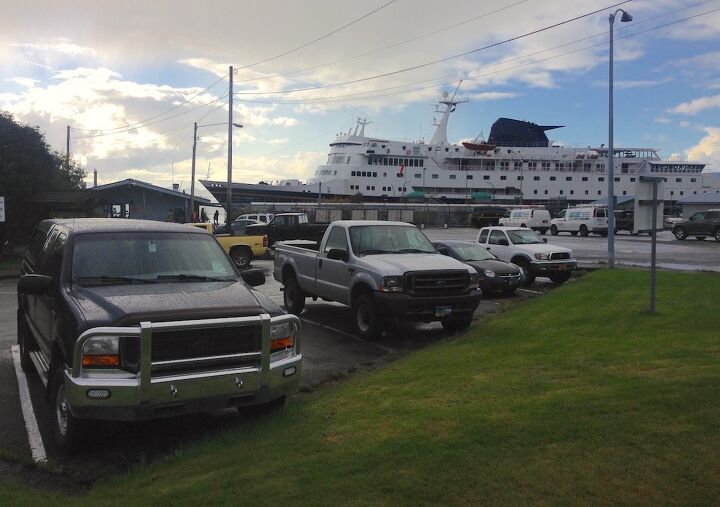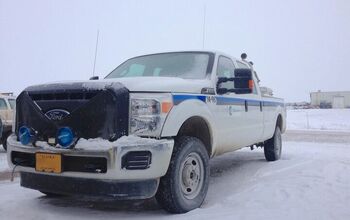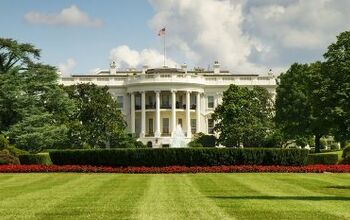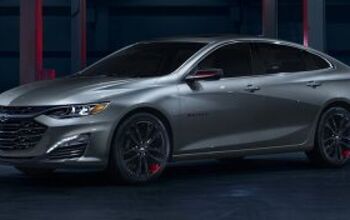U.S. North to South 2015: Wrangell and Ketchikan, Alaska
Leaving Petersburg to continue on our way south requires a ferry as Petersburg’s road network only reaches 30 miles out of town and does not cross any water along the way.
Next we visit Wrangell and Ketchikan before leaving Alaska for good. As well as analysing the car park in these two tiny towns, this is an opportunity for me to try and convey to you how it feels to take the most common means of transportation in Southeastern Alaska: the ferry.
“This is our highway, this is how we transport stuff” said one of the boat stewards during one of our trips. It really does feel that way on the Alaska Marine Highway ferry.
Slow, convoluted and expensive as soon as you need to transport more than just yourself, the Marine Highway is your bloodline if you are one of the 95 percent of Southern Alaskans that don’t own a personal floatplane. I saw locals drive into the car deck, drop their cargo and leave before the ship set sail as someone else would be picking it up the cargo at its destination. Visit times for pets on the car deck are regimented and religiously respected, and the snack bar is open 22 hours per day.
The ferry allows life to go on uninterrupted here.
The Alaska Marine Highway takes you either way from Skagway in Southern Alaska to Haines (1 hour), Juneau (5 1/2 hours), Petersburg (10 hours), Wrangell (4 hours), Ketchikan (6 hours) and finally to Prince Rupert in British Columbia, Canada (13 hours) or Bellingham in Washington State, USA (39 hours). The ferries operate almost daily during summer and all but stop in winter. Twice a month during summer the ferry crosses the Gulf of Alaska from Haines to Yakutat then on to Whittier near Anchorage.
I took the Juneau to Bellingham arm of the trip, meaning I never left U.S. territory and the various ferries I hopped on all stayed on Alaskan time (one hour behind Pacific time). Being that the ferry is a service provided by the State of Alaska, onboard personnel are public servants which creates a rather interesting anomaly: it is illegal to tip waiters!
The times to reach places are obviously longer, but it does make you re-evaluate car transport as the default option for everything.
This slower pace and unique route also gives you access to completely unscathed huge swaths of wilderness. Literally thousands of miles of forests, fjords, glaciers, snow-capped alpine peaks, and — to my relief — a very calm sea, are what you’ll be met with on this journey. If you think you were lucky spotting one humpback whale on your last touristic outing, the waters in this part of the world are literally streaming with them to the point where I can’t remember how many I spotted, especially between Juneau and Petersburg. Sometimes two or three of them do a simultaneous tail wave. Sailing Alaska’s waters is an absolutely unforgettable experience and one I highly recommend over flying if you find yourself in this part of the world. As the weather is highly unpredictable, chances are you won’t see anything from a plane anyway.
My most eagerly anticipated crossing during my ferry trip was just after Petersburg: the Wrangell Narrows passage — a.k.a. ‘pinball alley’ — which requires the vessel to negotiate 46 turns during a 22-mile section that is only 300 feet wide and 19 feet deep at times. I was expecting steep cliffs on each side but the landscape was actually quite flat and made the crossing a little less impressive from the boat. It would be quite a sight from shore to see the ferry towering over its surroundings.
We then arrived at Wrangell, one of the oldest towns in Alaska and the only one to have existed under three flags and ruled by four nations: Tlingit, Russia, Britain and America.
During the gold rushes up the nearby Stikine River between 1861 and 1897, Wrangell was described as a “lawless, ruthless pit”. With the timber industry crashing in the 1990s, Wrangell has been struggling to find its balance, though it seems now to have turned a corner as the town is gaining residents ( as opposed to Petersburg) according to the 2010 census. Cruise ships are only a once-a-week occurrence, so the town is less gentrified. Welcoming locals take pride in making sure you don’t miss the ‘elephant head’ mountain across from town, even if you just stop for the 15 minutes the ferry allows.
The car park of Wrangell is a collection of middle-aged, full-sized pickups such as 1980s Ford F-150s and early 2000s Ford F-250s, as well as a few mid-sized trucks like the Ford Ranger and Toyota Tacoma. SUVs follow while passenger cars are rare.
From there I went to Ketchikan. Once known as the “Canned Salmon Capital of the World,” Ketchikan now settles for the “First City” tagline as this is the first Alaskan port for northbound ferries and cruise ships. Fishing still accounts for roughly one-third of the local economy, but tourism is what makes this town’s heart beat. Somewhat sadly, Ketchikan is now a major cruise ship port-of-call, though no ships were denaturing the landscape while I was here. Another (sizeable if you ask me) handicap of Ketchikan is its unbelievable annual rainfall.
Looking up the Ketchikan section on the Alaska Lonely Planet reads: “If you stay in Ketchikan longer than an hour, chances are good that it will rain at least once if not several times.”
Correct.
Note that local residents have given up using umbrellas and go on with their life as if the sun was shining at its fullest. Ketchikan’s cruise-ship-induced wealth is noticeable on the street: brand-new Ford F-250s and Ram 2500s are a common occurrence. The larger the better as far as Ketchikan inhabitants are concerned. You can see all Alaskan sales figures here.
Next we leave Alaska to hit Seattle, Washington.
Matt Gasnier is based in Sydney, Australia. He runs a website dedicated to car sales statistics, trends and analysis called BestSellingCarsBlog. The website features sales data for 190 countries worldwide including 80 countries updated monthly.
More by Matt Gasnier
Latest Car Reviews
Read moreLatest Product Reviews
Read moreRecent Comments
- Dave Holzman My '08 Civic (stick, 159k on the clock) is my favorite car that I've ever owned. If I had to choose between the current Civic and Corolla, I'd test drive 'em (with stick), and see how they felt. But I'd be approaching this choice partial to the Civic. I would not want any sort of automatic transmission, or the turbo engine.
- Merc190 I would say Civic Si all the way if it still revved to 8300 rpm with no turbo. But nowadays I would pick the Corolla because I think they have a more clear idea on their respective models identity and mission. I also believe Toyota has a higher standard for quality.
- Dave Holzman I think we're mixing up a few things here. I won't swear to it, but I'd be damned surprised if they were putting fire retardant in the seats of any cars from the '50s, or even the '60s. I can't quite conjure up the new car smell of the '57 Chevy my parents bought on October 17th of that year... but I could do so--vividly--until the last five years or so. I loved that scent, and when I smelled it, I could see the snow on Hollis Street in Cambridge Mass, as one or the other parent got ready to drive me to nursery school, and I could remember staring up at the sky on Christmas Eve, 1957, wondering if I might see Santa Claus flying overhead in his sleigh. No, I don't think the fire retardant on the foam in the seats of 21st (and maybe late 20th) century cars has anything to do with new car smell. (That doesn't mean new car small lacked toxicity--it probably had some.)
- ToolGuy Is this a website or a podcast with homework? You want me to answer the QOTD before I listen to the podcast? Last time I worked on one of our vehicles (2010 RAV4 2.5L L4) was this past week -- replaced the right front passenger window regulator (only problem turned out to be two loose screws, but went ahead and installed the new part), replaced a bulb in the dash, finally ordered new upper dash finishers (non-OEM) because I cracked one of them ~2 years ago.Looked at the mileage (157K) and scratched my head and proactively ordered plugs, coils, PCV valve, air filter and a spare oil filter, plus a new oil filter housing (for the weirdo cartridge-type filter). Those might go in tomorrow. Is this interesting to you? It ain't that interesting to me. 😉The more intriguing part to me, is I have noticed some 'blowby' (but is it) when the oil filler cap is removed which I don't think was there before. But of course I'm old and forgetful. Is it worth doing a compression test? Leakdown test? Perhaps if a guy were already replacing the plugs...
- Crown No surprise there. The toxic chemical stew of outgassing.



















































Comments
Join the conversation
In Ketchikan, is this is ferry terminal across from the Best Western Hotel? I was there for Three days in September 2014. The last cruise ship had come and gone, and in downtown all the stores were packing up their good to send them back or put them in a warehouse. Most streets were empty. I saw a good mix of cars/trucks/suv at Wal-Mart. I seem to recall a local telling me that most folks left once the cruise ship season is over, and fishing season closed. Lovely place. It stopped raining for a few hours so I could check out the creek downtown and watch the salmon run. I have been enjoying your articles/posts on your travels.
That Ford is about to chomp that Camaro for brunch.